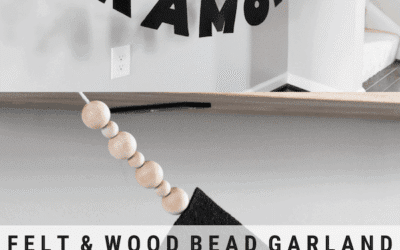If you keep your sewing machine out between projects, learn how to sew a sewing machine cover to protect it while it’s sitting out (and make it look better!).
Since I inherited my grandmother’s old sewing machine and have been sewing a lot more, I’ve been keeping the machine out between projects. I want to protect it from dust (and cats), so I usually just pop the hard cover it came with over it and let it be.
However, the cover isn’t anything to write home about. It’s bulky and not very aesthetically pleasing, so I decided to make a sewing machine cover so that the machine would look more like a decoration in the room.
I love how it turned out—the machine looks so much prettier sitting on my desk! It didn’t take too long, either—after about 1.5 hours of cutting and sewing, I went from this…

to this…!

- Stiff-ish fabric—I used this fabric, which I found in the home decor fabrics section of Jo-Ann (Your fabric doesn’t have to be extremely stiff or heavy, but it shouldn’t be something with a lot of stretch like a rayon-type knit)
- Scissors and pinking shears (I just got these, which are on the cheaper side, but they work quite well)
- Measuring tape, a marker, and pins
- Iron, ironing board, sewing machine
Measure your sewing machine (or, if your machine came with a cover, measure that). I made my cover using three pieces of fabric: one big piece that stretched from front to back and two smaller pieces for each side.
Here’s how I measured the length and width for the big piece (the one that stretched from front to back). Measure long-ways across the top (not the sides) and then from the bottom of the front to the bottom of the back.

And here’s how I measured the length and width for the smaller side pieces. Measure all four sides. My machine has a bit of a slope, so I decided to measure along that instead of using two rectangles for the sides. Either approach would be fine, and using two rectangles would be easier.
You also need to build in your desired seam and hem allowance. I did 1 inch on each side of each piece because I wanted the cover to fit loosely over the machine.

Once you’ve measured and marked your pieces, cut them out. I also recommend labeling them since it’s easy to get the pieces confused!


Pin the two side pieces to the the big piece as pictured below. On the side pieces, pin the edges that will be the two back seams. Pin to the bottom of the big piece. Ensure the right sides of the fabric are facing one another.
If your sides slope like mine did, you might want to drape the pieces over the machine to double check where and in which direction you need to pin the side pieces. That’s why using rectangular side pieces would be easier—you won’t need to worry as much about lining up the slope correctly.
Sew up the two seams you designated with pins like below. The second pic is after they are sewn on and flipped over.



Sew the top of each side piece along the side of the big piece. This is a bit tricky because you’re turning your fabric into a box shape rather than two flat pieces sewn onto one another.
I triple checked that I was sewing in the right place by draping the fabric over the machine and folding it over as shown below. Then I flipped it inside out, pinned, and sewed two more seams.
This is how it should look now: absolutely nothing like a sewing machine cover, but it’s getting there. Again, if you’re a visual person, you’ll probably want to drape the cover over your machine again ensure your last two seams are sewn in the right place to complete the cover’s structure. Pin and sew the last two seams up.



All the pieces are now attached to one another. Trim the seams using your pinking shears (this prevents fraying), then flip it right-side out and press the seams (below photo is before pressing). As you can see, I overshot my side piece measurements, but that’s okay. I just trimmed the excess fabric.
Hem the cover by folding about 1 inch of fabric under and pressing all the way around. Then finish it off with a straight seam.


And here’s the final product! Hope you’re as happy with yours. Mine drapes perfectly and makes the machine look a bit less drab when sitting out on the shelf.

If you’re looking for more easy sewing projects, check out my DIY envelope pillow covers, my tips for sewing a laptop sleeve, my DIY wrap cardigan tutorial, and my post on how to sew easy burp cloths!
Pin my post about how to sew a sewing machine cover!




0 Comments